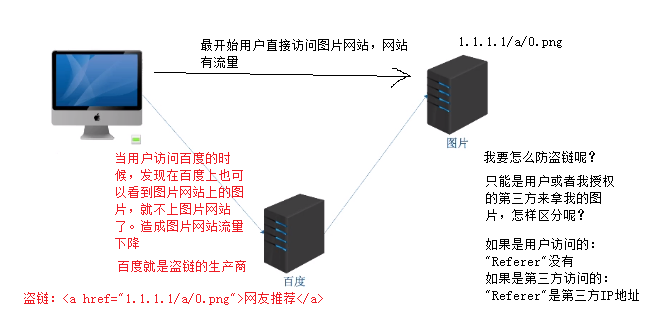一、默认网站
验证修改后的配置文件是否有问题:/usr/local/nginx/sbin/nginx -g ../conf/nginx.conf
# 当nginx配置文件中有且只有一个server的时候,该server就被nginx认为是默认网站 # 所有发给80端口的数据就会交给该server # 有多个server才称为虚拟主机 server { listen 80; server_name localhost; charset utf-8; # 不设定使用全局的,每个server有自己的access_log #access_log logs/host.access.log main; # 根目录下有两个HTML:ls nginx/html/ -> 50x.html index.html location / { root html; index index.html index.htm; } #error_page 404 /404.html; # redirect server error pages to the static page /50x.html # error_page 500 502 503 504 /50x.html; location = /50x.html { root html; } }
二、nginx目录访问控制
#根目录下的目录a:例如nginx/html/a # 配置文件中的location是相对于根目录 #/usr/local/nginx/html location /a { allow 127.0.0.1; #只允许本机访问a目录下的文件 deny all; }
三、nginx登录验证
# 目录用户验证:b目录下的资源需要用户密码才能访问 location /b { auth_basic "登录验证"; auth_basic_user_file /etc/nginx/htpasswd; # 保存的查看b目录的账号密码 }
/etc/nginx/htpasswd:保存用户名和密码,格式为“用户名:密码”,密码必须加密否则无法通过验证
使用命令:
1.安装htpasswd命令:yum -y install httpd-tools
2.创建文件(创建文件时要指定创建一个用户):htpasswd -c /etc/nginx/htpasswd alex
3.创建用户sky并输入密码:htpasswd -m /etc/nginx/htpasswd sky
四、日志管理
nginx访问日志主要有两个参数控制 1)log_format #用来定义记录日志的格式(可以定义多种日志格式,取不同名字即可) log_format log_name string 2)access_log #用来指定日志文件的路径及使用的何种日志格式记录日志 access_log logs/access.log main; #步骤:先定义一个日志格式,再定义一个日志文件才用这个格式, #例如:定义一个日志“haha”并应用 log_format haha '[$time_local] $remote_addr "$request" $status' access_log logs/host.access.log haha #也可以把日志定义为json格式: log_format main_json '{' '"@timestamp": "$time_local",' '"client_ip": "$remote_addr",' '"request": "$request",' '"status": "$status",' '"bytes": "$body_bytes_sent",' '"x_forwarded": "$http_x_forwarded_for",' '"referer": "$http_referer",' '}'; access_log logs/access_json.log main_json; #应用 ---------------- log_format格式变量: $remote_addr:用于记录访问网站的客户端的ip地址; $remote_user:用来记录客户端用户名称; $time_local:用来记录访问时间与时区; $request:用来记录请求的url与http协议; $status: 用来记录请求返回的状态码;成功是200 $body_bytes_sent:服务器发送给客户端的响应body字节数 $http_referer:用来记录从哪个页面链接访问过来的,可以根据该参数进行防盗链设置; $http_user_agent:记录客户浏览器的相关信息; $http_x_forwarded_for:当前端有代理服务器时,设置web节点记录客户端地址的配置,此参数生效的前提是代理服务器也要进行相关的x_forwarded_for设置
五、防盗链
什么是盗链?
如何使用请求头中的Referer来防盗链?

192.168.1.9作为“源图片服务器”:
访问http://192.168.1.9/a/xxx.png出现图片
192.168.1.10作为盗链机器:
访问http://192.168.1.10返回盗链 <a href="http://192.168.1.9/a/xxx.png">盗链</a>
# 例如要访问c文件夹中的图片(c里存的图片) # 允许:none表示用户 blocked表示防火墙 *.self.com表示自己或授权第三方 # 拒绝:非上面三种的访问,返回403 location /c { #location ~* .(png|gif|bmp)$ { # 这个表示网站里所有图片都不能访问 valid_referers none blocked *.self.com; if ($invalid_referer){ return 403; } }
六、nginx虚拟主机
虚拟主机介绍
一个web服务器软件默认情况下只能发布一个web,因为一个web分享出去需要三个条件(IP、Port、域名)
使用一个web服务器软件发布多个网站
虚拟主机:把一台物理服务器划分为多个虚拟服务器,每一个虚拟主机都可以有独立的域名和独立的目录
- 基于IP的虚拟主机
条件:
1)两个IP:192.168.10.42:80;192.168.10.52:80;使用逻辑网卡
2)DR存在
DocumentRoot /usr/local/nginx/html/web1
DocumentRoot /usr/local/nginx/html/web2
3)索引页 index.html
添加逻辑网卡:ifconfig ens33:1 192.168.10.22 up
ens33:本地网卡名称,通过ifconfig查看
192.168.10.22:逻辑网卡地址
缺点:
# 每个网站都需要一个IP
# 缺点 需要多个IP 如果是公网IP 每个IP都需要付费
配置文件:
server { listen 192.168.10.42:80; location / { root html/web1; index index.html index.htm index.php; } } server { listen 192.168.10.52:80; location / { root html/web2; index index.html index.htm index.php; } }
- 基于端口的虚拟主机
缺点:
# 只需要一个IP
# 缺点 端口你是无法告诉公网用户 无法适用于公网用户,适合于内部用户
server { listen 80; location / { root html/web1; index index.html index.htm index.php; } } server { listen 8080; location / { root html/web2; index index.html index.htm index.php; } }
- 基于域名的虚拟主机
# 一个网站必然有一个域名
# 公网域名是在dns服务器上解析的,做实验的时候只能在 /etc/hosts 里做强制解析
server { listen 80; server_name www.abc.com; location / { root html/web1; index index.html index.htm index.php; } } server { listen 80; server_name www.cbd.com; location / { root html/web2; index index.html index.htm index.php; } }
24234